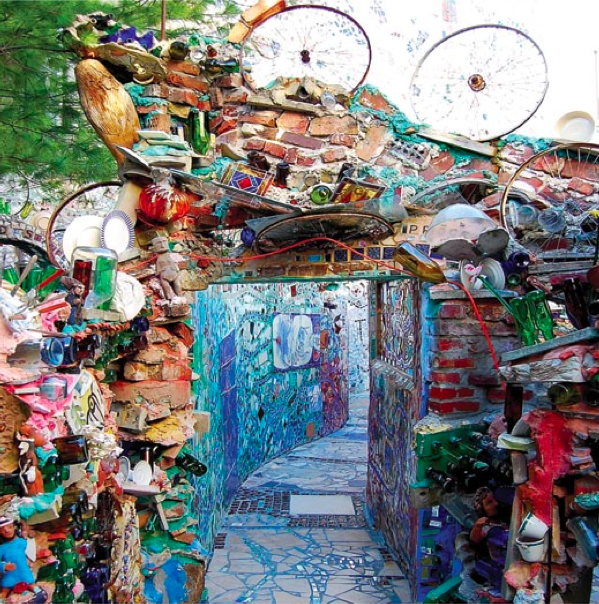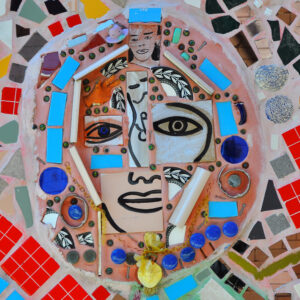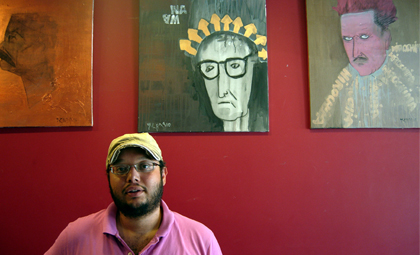
Zagar's sanctuary, courtesy of Emily Smith
A welter of anxious faces study the jagged walls protruding with bottles, ceramics and tiles. Held together by cement, more bottles spring from wall edges like barbed wire on a fence. Bent rusty wheels, broken mirrors, sinking ship—a perverse Park Güell? This is not the famous mosaics park in Barcelona or stage set designed by cartoonist and animator Tim Burton; rather, a open-air labyrinthine museum of life-size mosaic sculptures, wrapped around walls, constructed by Isaiah Zagar.
The award-winning muralist sits at a round table with friends at his favorite Vietnamese eatery, in Philadelphia’s South Side neighborhood. Under the guise of a shipwrecked beach comer, he takes a swig of beer, and then unintentionally knocks down a bottle or two. His friend, luminary artist Warren Muller watches with amusement; his smile frozen in a boyish manner. After four decades of friendship, Muller still absorbs the inspiration of his friend’s extensive and grandiose mosaic works— marked by an unstructured medium of street objects, he uses to tame his chaotic sensibilities.
Wiping a soft noodle drooping down his beard, Zagar leans back in his chair and proceeds with his first lesson on vernacular environmental art. “Vernacular artists find objects, knock ‘em down, and create new art they call their own,” he says, explaining that the unskilled and untrained bunch are misunderstood by artists and rural communities, for their ‘crazy’ art polluting urban spaces. The late artist and James Hampton, was honored for his scavenged material referencing religion, only after his landlord found him dead in his Washington D.C. apartment.
A vernacular artist himself, Zagar tells me about the staircase he built with random objects, without using proper measurement tools. “The elevator bumped against the staircase,” he remarks. “I had to tear that thing down.” Clearly enjoying himself, the muralist has created more art than he has destroyed. His monumental pieces capture four endless decades of collecting glass, tiles, ceramics, bicycle wheels and random figurines to cement and glue on public walls. Once, at Koehler’s industrial plant in Wisconsin, he fired ten thousand pounds of raw ceramics using gigantic kilns. With one hundred fifty sculptures under his belt, in the Philadelphia metropolitan area, he has enough material to produce dozens more.
It is no surprise that at 72, with an upbringing in 1960s New York City, the eccentric is a hard-edge product of the hippy era. The Woodstock flower child, swimming in drugs and peace-loving advocacy, has admitted to experiencing several nervous breakdowns and has checked himself into institutions for help. 1968, “the year of the nervous breakdown,” and also the year the Peace Corps sent Zagar to Peru.
While traveling, he met his wife Julia, and they settled their courtship in downtown Philadelphia during the heat of the Civil Rights protests between the blacks and whites. “The Civil Rights movement went berserk,” he says, recalling the then novel scenario of protest, repression, outrage, and renewed protest—a drama playing out in city’s streets and alleyways. Equally important, he adds, the Vietnam War fueled the turmoil similar to Lebanon’s in 2006.
“Then the state wanted to build an expressway in South Street!,” he recalls, stirring an outcry among residents and artists. “It was about forty of us, the ‘South Street Renaissance,’ marching down the street.” It was a kind of ‘us against the world’ mentality that soldered the artist, volunteers and entrepreneurs together, leading the city to abandon the project. It is on the walls of South Street and desolate alleyways sucked dry after Americans’ relocation to the suburbs that Zagar crafts his mosaics, unmolested.
The city doesn’t finance his endeavors or comment much on the beautification of its neighborhoods. Occasionally, he receives grants from public museums and galleries. Back then and now, he purchases low-cost empty lots, abandoned warehouse and apartments buildings using his Peace Corps savings and rent earnings to support his artist lifestyle. For years, he has been renovating and embellishing its interior walls with mosaics, sequestering himself for hours with cement, and paint, brushes and hammers.
Unlike his favorite folk art environmentalist and ‘outsider artist’ Clarence Schmidt, the pioneer refuses to act as lone wolf. He has no partners, only helpers. Most of them are middle- aged or retired community members who attend his workshops. He teaches them to mix cement, cut glass, and glue broken tiles to the wall. Others come to donate mounds of tiles, or simply pay a visit like American First Lady Michelle Obama.
At Watkins, the name of the city street and his most recent project, an Iranian helper named Majid breaks tiles with a hammer. He then glues them into a wall of the two-storied atelier—a former mechanical shop. Remarkably, the façade and all four walls, are already covered in mosaics. Floral painted tiles from Mexico and broken mirrored pieces from Philly are cemented adjacent to large ceramic tiles, with images of dancing unclad women. As broken porcelain pottery jots out of negative spaces, wooden Indian elephants jolt out of random wall sections.
There is more: old wooden chairs, older rug-covered mattress, and even older table-top lamps, centered beside tall wooden nude sculptures imported from Southeast Asia. With influences that include cave drawings, Greek and Roman mosaics, Henry Matisse and Pablo Picasso, the various aesthetics and materials are astonishing. His visual stimulation shocks, titillates, and arouses bystanders. The young-hearted man follows his inner voice, saying, “I don’t know if it’s a surrealist stream of consciousness or something else.” He is also open to the possibility that his sense of chaos resembles that of Picasso’s.
To demonstrate how his mind works, suddenly, he draws what looks like a bear with green paint through a silhouette of a boy’s face without considering its ramifications. “Art can be in the foreground or background,” he says, continuing to draw bodies of animals and people from the already assembled pieces of mosaics. Later, he fills the negative spaces color dyed cement using dish sponges, before polishing tile surface with glove buffers. Meanwhile, Majid follows orders: “Glue mirrors on the wall!” “Then the sea shells!” “Break those tiles!” Majid, Zagar’s third arm—extends his help his boss endlessly seeks simulation of new sensations, the excitement of experience that only a doggedly, literal-minded individual couldn’t comprehend. The mosaics heal and beautify the artist’s life—“because the drama that comes from me is sometimes extraterrestrial,” he says, on his intuitive and spontaneous creations. In contrast, he despises isolated spaces of grim building codes propagated by Soviet communists, and ironically, abhors architect Frank O. Gehry’s Disney Concert Hall. Pointing out his loosely integrated exterior and interior designs, with a tint of animosity he calls Gehry, “an egocentric bastard that didn’t understand how artists can help with his dream concept.” Zagar’s fragmented and asymmetrical art, at its pinnacle, is trademarked The Magical Gardens on South Street.
Fourteen years in the making, the convoluted museum is a child’s dream. His inspiration reaches into European Impressionism, where he replicates the Florentine magic of living galleries— outdoor and indoor plazas, alleyways and intersections. He also mimics mosaic aspirations of architect Antoni Gaudí in Cathedral Sagrada Familia and Park Guell. The Gardens like Guell, is a sanctuary for public art venues, conversation, and playtime. Again we sit at a table—squared, not round—and watch children study their reflections in the Gardens’ mirrors. “Here, I renewed my vows with Julia… and Warren was our priest wearing a beehive hat,” he says, observing a young girl reading a quote by Schmidt. Painted on a row of cluttered tiles, it reads: “I built this sanctuary to be inhibited by my ideas and my fantasies.”
Those who personally share a conversation with the vernacular artist believe that his enjoyment for work proceeds from a liberation of tension in his mind, and while it is difficult to understand his creative spirit and his megalomania, the old artist finally comes to peaceful terms with life, work, and family. His son, Jeremiah, documented his father’s range of emotions from grief to joy in the film, “In A Dream.” He remarks: “My father is older and sweeter now…he is frail, but human and real.”
Additional reporting by Eric Joseph Reitmeyer
The full featured article in RagMag August 2011 (PDF)
[issuu width=550 height=359 pageNumber=30 backgroundColor=%23222222 documentId=110902194512-3f348039d52b4d1c8df22fbf22d31761 name=ragmag_august_2011 username=ragmag tag=anti%20gravity unit=px id=48c21473-f492-03f6-0494-93a547a654c9 v=2]






